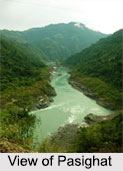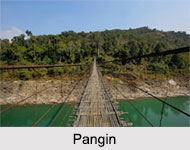 Pasighat, the headquarters of East Siang District of Arunachal Pradesh, is located at the eastern foothills of the Himalayan ranges at an altitude of 155 meters above sea level. It is located at 28.07 ° N and 95.33 ° East. This is the oldest town of Arunachal Pradesh. In June 2017, the Government of India included this town in the Smart Cities Mission Development Scheme.
Pasighat, the headquarters of East Siang District of Arunachal Pradesh, is located at the eastern foothills of the Himalayan ranges at an altitude of 155 meters above sea level. It is located at 28.07 ° N and 95.33 ° East. This is the oldest town of Arunachal Pradesh. In June 2017, the Government of India included this town in the Smart Cities Mission Development Scheme.
History of Pasighat
The town Pasighat was founded in 1911 A.D. by the British Empire as a gateway to administrative convenience of the greater Abor Hills and the north area in general. Initially there were settlements of Adi (ancient) tribal people who are still living in the villages in and around Pasighat. Pasighat celebrated its 100 years of existence in the year 2011.
Climate of Pasighat
Pasighat has a subtropical climate with typical lowland Northeast Indian humid condition, which is a little too cool to qualify as a tropical monsoon climate. Being surrounded by high hills on three sides, Pasighat attracts rain bearing clouds of Assam plain. The rain bearing wind gets prevented by the hills and brings exceptionally heavy rainfall from June to September; the average monthly rainfall is 796 millimeters. Winter in this region is strong, cool and dry due to the northeasterly winds from the Siberian High.
Demography of Pasighat
Pasighat has a population of 24,656. Males constitute 50.62% of the population and females 49.37%. Pasighat has an average literacy rate of 79.6%; male literacy is 85.33% and female literacy is 73.74%. In Pasighat, 12% of the population is under 6 years of age. Pasighat is predominantly inhabited by the Adi people; they are known for their colourful Ponung dance and war dance, which is called Taapu.
Economy of Pasighat
The main occupation of the local people of Pasighat is agriculture. Rice is the main food crop produced in this area. There are several large tea gardens near the town where several workers from all over the region come for working. Along with agriculture, horticulture and tourism are also the other sources of economy of the town.
Festivals in Pasighat
The people of Pasighat celebrate a variety of festivals. Solung, Aran, Etor are the important festivals of Pasighat. Among these festivals Solung is the main festival of the Adi people. It is heard that the Solung festival came into existence after the Goddess of wealth Kiine-Naane had asked them in person to carry out this worship or `puja`. This festival is celebrated for five days in the month of September.
The first day, which is Solung Gidi Dogin is the day when they prepare for this event. Doreph Long or the second day is the day of animal slaughters. Binnyat Binam or the third day is the day of prayers. Taktor of Ekoph is the fourth day to manufacture arms and ammunition. Miri or the fifth day is the day of farewell. The songs which are sung during Solung are the lyrics of Solung Abang that show the life of humans, animals, plants etc.
 Tourism in Pasighat
Tourism in Pasighat
Pasighat is quiet rich in term of tourism and popular among tourists as well. Several places are there to visit in Pasighat and they are:
Daying Ering Wildlife Sanctuary: It is one of the most popular wildlife parks of Arunachal Pradesh. Spread over an area of 190 sq km, diluvial grasslands cover most of the area and wooded areas constitute about 15%; the rest portion is water. The sanctuary has a wide range of species of animals and birds.
Pangin: Pangin is about 60 km from Pasighat. It stands at the meeting point of River Siyom and River Siang. This place is popular among tourists for its scenic beauty. Here are also a number of rare plants and herbs having medicinal importance.
Bodak Scenic Area: The Bodak-Mebo-Jengging Scenic Area is a popular picnic spot for tourists from neighbouring states, towns and the residents of Pasighat. The scenic area is a large forested area with villages and agricultural lands. This spot is 15 km from Pasighat main town.
Kekar Monying: It is a mountain cliff near Rottung, which is an important historical place because of its strong resistance of Adi people against the British in 1911. The war was the part of a punitive expedition undertaken by the British for murdering Noel Williamson, a political officer.
Komlighat: Earlier Komlighat was a river port. Now it is a popular evening spot, which is frequented by families, youngsters, and the health conscious people. The spot is also popular for its street food. The ghat provides a wonderful view of the Siang River and the hills surrounding the Pasighat plains.
Gomsi: Gomsi is a cultivation area near Rani Village. This area has some historical importance as well. In June 1996, some evidences of early medieval period (probably pre-Ahom) were found from this place in an excavation.
Apart from these places some other visiting spots of Pasighat are Komsing, Pasighat Buddhist Temple, East Siang District Museum, Adi Baane Kebang Headquarters etc. Pasighat is also ideal for adventure sports activities.
Visiting Information to Pasighat:
The nearest airport to reach Pasighat is Dibrugarh Airport, which is 167 km from the place. Nearest railway station of this place is Murkong Selek Station (35 km). The city is well connected by bus routes; one can reach there by buses from Dibrugarh, Assam via national highway 515 or via national highway 590 via Guwahati, Assam.



















